|
|
|
Sort Order |
|
|
|
Items / Page
|
|
|
|
|
|
|
| Srl | Item |
| 1 |
ID:
062182


|
|
|
|
|
| Publication |
Cheltenham, Edward Elgar, 2004.
|
| Description |
x, 219p.
|
| Series |
ERSI studies series on the environment
|
| Standard Number |
1843769239
|
|
|
|
|
|
|
|
|
|
|
|
Copies: C:1/I:0,R:0,Q:0
Circulation
| Accession# | Call# | Current Location | Status | Policy | Location |
| 049668 | 333.79/SCH 049668 | Main | On Shelf | General | |
|
|
|
|
| 2 |
ID:
045266


|
|
|
|
|
| Publication |
Stanford, Stanford University, 1979.
|
| Description |
24p
|
|
|
|
|
|
|
|
|
|
|
|
Copies: C:1/I:0,R:0,Q:0
Circulation
| Accession# | Call# | Current Location | Status | Policy | Location |
| 019882 | 333.79/RAY 019882 | Main | On Shelf | General | |
|
|
|
|
| 3 |
ID:
127907


|
|
|
|
|
| Publication |
2014.
|
| Summary/Abstract |
This paper introduces a new agent-based model, which incorporates the actions of individual homeowners in a long-term domestic stock model, and details how it was applied in energy policy analysis. The results indicate that current policies are likely to fall significantly short of the 80% target and suggest that current subsidy levels need re-examining. In the model, current subsidy levels appear to offer too much support to some technologies, which in turn leads to the suppression of other technologies that have a greater energy saving potential. The model can be used by policy makers to develop further scenarios to find alternative, more effective, sets of policy measures. The model is currently limited to the owner-occupied stock in England, although it can be expanded, subject to the availability of data.
|
|
|
|
|
|
|
|
|
|
|
|
|
|
|
|
| 4 |
ID:
171390


|
|
|
|
|
| Summary/Abstract |
Addressing the threat of global climate change will require large-scale transformation of our energy systems. Scholars are increasingly calling for a more systemic approach to studying energy transitions—one that incorporates human dimensions such as behaviors, attitudes, perceptions, and preferences. Drawing on an exploratory representative study (n = 379 surveys) conducted in the Pogány-havas microregion of eastern Transylvania, Romania, we employ Stephenson et al.’s Energy Cultures Framework to describe and discuss the social and material energy system of the region. We highlight the interactions between norms, energy practices and material culture, as well as external influences that are shaping the energy system. We discuss attitudes towards energy conservation and acceptability of community renewable energy schemes. Based on our findings, we define the dominant energy culture of the region and highlight elements of the system that are either reinforcing the status quo or shaping a more sustainable energy culture. We discuss implications for increasing the efficiency of the energy system of this region and factors that could inform energy policies and sustainability interventions. We conclude by situating our research within a larger narrative of rural energy transitions and discuss the value of a systems approach when undertaking energy systems research.
|
|
|
|
|
|
|
|
|
|
|
|
|
|
|
|
| 5 |
ID:
167010


|
|
|
|
|
| Summary/Abstract |
Behavioural interventions, such as informational nudges, have become an increasingly popular strategy in demand-side energy management. In particular, home energy reports (HERs) have been used to induce behavioural change among residential consumers. These HERs typically provide peer comparisons of energy use and information about energy savings opportunities. Despite the growing prevalence of HERs and a shift from postal to electronic delivery of HERs, the experimental evidence base of their effectiveness comes primarily from HERs delivered by post from a single vendor (Opower). Whether that evidence generalises to other programmes and to the electronic delivery of HERs is unclear. This paper reports new evidence for HER effectiveness from a 12-month field experiment with approximately 9,000 households that tested electronic HER programme in a deregulated American residential electricity market. Despite high non-compliance with HER delivery, the programme reduced household electricity consumption by 2.9%, 95% CI [-5.0%, −0.76%]. This estimated reduction is consistent with prior estimated impacts of HERs delivered by post and implies electronic HERs are at least as effective as reports delivered by post in reducing electricity consumption, while they are administered at a lower cost.
|
|
|
|
|
|
|
|
|
|
|
|
|
|
|
|
| 6 |
ID:
109359
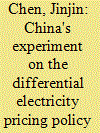

|
|
|
|
|
| Publication |
2011.
|
| Summary/Abstract |
Differential electricity pricing was promulgated by China's central government to guide the development of high energy-consuming industries, which are significant for energy conservation. This paper examines the twists and turns of the policy implementation at the provincial level, and seeks to elucidate the difficulties in its implementation. Local governments, concerned that following the central directives would hurt local interests, have tried to deviate from the central orders while the central revises the policy from time to time to ensure local compliance. Three difficulties are analyzed: (1) the current relations between the central and local energy regulatory institutions make these local institutions difficult to perform their duties, and affect incentives for local governments to respond to central directives; (2) financial reform puts a great burden on local governments to raise revenues to cover expenditures, making local governments focus mainly on economic development rather than serving merely as political agents of the central government; (3) the aggressive attitude of local governments in pursuing GDP growth is not necessarily driven by the central government, but by pressure from competition among localities and the need to win local support. Solving these difficulties is important for making national energy conservation polices effective and efficient.
|
|
|
|
|
|
|
|
|
|
|
|
|
|
|
|
| 7 |
ID:
128377
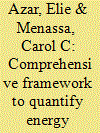

|
|
|
|
|
| Publication |
2014.
|
| Summary/Abstract |
While studies highlight the significant impact of actions performed by occupants and facility managers on building energy performance, current policies ignore the importance of human actions and the potential energy savings from a more efficient operation of building systems. This is mainly attributed to the lack of methods that evaluate non-technological drivers of energy use for large stocks of commercial buildings to support policy making efforts. Therefore, this study proposes a scientific approach to quantifying the energy savings potential due to improved operations of any stock of commercial buildings. The proposed framework combines energy modeling techniques, studies on human actions in buildings, and surveying and sampling methods. The contributions of this study to energy policy are significant as they reinforce the role of human actions in energy conservation, and support efforts to integrate operation-focused solutions in energy conservation policy frameworks. The framework's capabilities are illustrated in a case study performed on the stock of office buildings in the United States (US). Results indicate a potential 21 percent reduction in the current energy use levels of these buildings through realistic changes in current building operation patterns.
|
|
|
|
|
|
|
|
|
|
|
|
|
|
|
|
| 8 |
ID:
166977
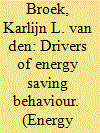

|
|
|
|
|
| Summary/Abstract |
Campaigns aiming to induce energy saving behaviour among householders use a wide range of approaches that address many different drivers thought to underpin this behaviour. However, little research has compared the influence of the different processes that influence energy behaviour, meaning campaigns are not informed about where best to focus resources. Therefore, this study applies the Comprehensive Action Determination Model (CADM) to investigate the relative influence of intentional, normative, situational and habitual processes on energy saving behaviour. An online survey on a sample of Western European households (N = 247) measured the CADM variables and data were analysed using structural equation modelling. Results showed that 1) the model was able to account for a large amount of variance in energy saving behaviour and 2) situational and habitual processes were best able to account for energy saving behaviour while normative and intentional processes had little predictive power. These findings suggest that policy makers should move away from motivating householders to save energy and should instead focus their efforts on changing energy habits and creating environments that facilitate energy saving behaviour. These findings add to the wider development in social and environmental psychology that emphasizes the importance of extra-personal variables in shaping behaviour.
|
|
|
|
|
|
|
|
|
|
|
|
|
|
|
|
| 9 |
ID:
125825


|
|
|
|
|
| Publication |
2013.
|
| Summary/Abstract |
Critics have speculated that the limited success of energy conservation programs among low-income consumers may partly be due to recipients having insufficient literacy to understand the outreach materials. Indeed, we found outreach materials for low-income consumers to require relatively high levels of reading comprehension. We therefore improved the Flesch-Kincaid readability statistics for two outreach brochures, by using shorter words and shorter sentences to describe their content. We examined the effect of that simplification on low-income consumers' responses. Participants from low-income communities in the greater Pittsburgh area, who varied in literacy, were randomly assigned to either original communications about energy conservation programs or our simplified versions. Our findings suggest that lowering readability statistics successfully simplified only the more straightforward brochure in our set of two, likely because its content lent itself better to simplification. Findings for this brochure showed that simplification improved understanding of its content among both low-literacy and high-literacy recipients, without adversely affecting their evaluation of the materials, or their intention to enroll in the advertised programs. We discuss strategies for improving communication materials that aim to reach out to low-income populations.
|
|
|
|
|
|
|
|
|
|
|
|
|
|
|
|
| 10 |
ID:
132592
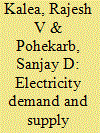

|
|
|
|
|
| Publication |
2014.
|
| Summary/Abstract |
Forecasting of electricity demand has assumed a lot of importance to provide sustainable solutions to the electricity problems. LEAP has been used to forecast electricity demand for the target year 2030, for the state of Maharashtra (India). Holt's exponential smoothing method has been used to arrive at suitable growth rates. Probable projections have been generated using uniform gross domestic product (GDP) growth rate and different values of elasticity of demands. Three scenarios have been generated which include Business as Usual (BAU), Energy Conservation (EC) and Renewable Energy (REN). Subsequent analysis on the basis of energy, environmental influence and cost has been done. In the target year 2030, the projected electricity demand for BAU and REN has increased by 107.3 per cent over the base year 2012 and EC electricity demand has grown by 54.3 per cent. The estimated values of green house gas (GHG) for BAU and EC, in the year 2030, are 245.2 per cent and 152.4 per cent more than the base year and for REN it is 46.2 per cent less. Sensitivity analysis has been performed to study the effect on the total cost of scenarios. Policy implications in view of the results obtained are also discussed.
|
|
|
|
|
|
|
|
|
|
|
|
|
|
|
|
| 11 |
ID:
168300


|
|
|
|
|
| Summary/Abstract |
The financial cost of personal energy consumption is substantial at the organizational level. Rarely do incentives for saving energy for the individual employee and organization align, making conservation a challenge. Here we perform a 12-week field experiment piloting two behavioral strategies: (1) social norms feedback and (2) awareness of energy monitoring, to encourage savings among 46 administrative staff at a university who were given the impression of participating in an energy quality study to reduce self-selection bias. Those in the social norms feedback condition used significantly less energy during the intervention (10% less energy) and follow up monitoring (11% less energy) phases compared to their baseline consumption. Moreover, these participants demonstrated that they learned more about their energy use than did those in the awareness monitoring condition. For policy makers and building mangers interested in the effectiveness of behavioral nudges in inducing energy savings, social norms feedback appears to be an effective energy savings nudge in an organizational setting where there are neither financial savings at-stake nor intrinsic motivation to conserve.
|
|
|
|
|
|
|
|
|
|
|
|
|
|
|
|
| 12 |
ID:
045552
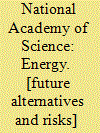

|
|
|
|
|
| Publication |
Cambridge, Ballinger Publishing Company, 1974.
|
| Description |
ix, 227p
|
| Series |
National academy of science series
|
| Standard Number |
0884100251
|
|
|
|
|
|
|
|
|
|
|
|
Copies: C:1/I:0,R:0,Q:0
Circulation
| Accession# | Call# | Current Location | Status | Policy | Location |
| 023178 | 333.79/NAT 023178 | Main | On Shelf | General | |
|
|
|
|
| 13 |
ID:
045273


|
|
|
|
|
| Publication |
Washington, National Defense Universisty Press, 1981.
|
| Description |
xii,176p
|
|
|
|
|
|
|
|
|
|
|
|
Copies: C:1/I:0,R:0,Q:0
Circulation
| Accession# | Call# | Current Location | Status | Policy | Location |
| 020594 | 333.79/ENE 020594 | Main | On Shelf | General | |
|
|
|
|
| 14 |
ID:
115672


|
|
|
|
|
| Publication |
2012.
|
| Summary/Abstract |
Energy is required to sustain life. A human-centered analysis of the worldwide energy situation is conducted in terms of quality of life-related variables that are affected, but not directly determined, by energy consumption. Data since 1980 show a continuous global increase in both energy consumption and quality of life, and lower population growth in countries with higher quality of life. Based on these trends, we advance non-linear energy consumption predictions and identify various plausible scenarios to optimally steer future energy demands, in order to maximize quality of life. The scenarios consider the coupling between energy consumption rate per capita, quality of life, population growth, social inequality, and governments' energy-for-life efficiency. The results show the energy cost of increasing quality of life in the developing world, energy savings that can be realized by limiting overconsumption without impacting quality of life, and the role of governments on increasing energy-for-life efficiency and reducing social inequality.
|
|
|
|
|
|
|
|
|
|
|
|
|
|
|
|
| 15 |
ID:
105786


|
|
|
|
|
| Publication |
2011.
|
| Summary/Abstract |
Because of China's increasingly limited energy supplies and serious environmental pollution, much attention has been paid to conserving energy and reducing emissions to help the country's economy achieve sustainable development. As the electric power industry is the largest consumer of coal resources in China and also emits high levels of air pollutants each year, the Chinese government has enacted many technical and economic policies for energy conservation and emission reduction in the last few years. These policies are summarized in this paper, along with relevant laws and medium- and long-term plans, all of which address ideas such as adjusting the power generation mix, promoting demand-side management, introducing energy-efficient scheduling, and installing desulfurization units. The paper also assesses the results of these policies by analyzing several key indicators of energy consumption and emissions. The analysis shows that although some progress has been made in conserving energy and reducing emissions, substantial work is still required for China to catch up with developed countries. Some suggestions for future work are provided.
|
|
|
|
|
|
|
|
|
|
|
|
|
|
|
|
| 16 |
ID:
113378
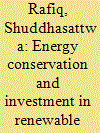

|
|
|
|
|
| Publication |
2011.
|
| Summary/Abstract |
This paper investigates the dynamic relationships between output, energy consumption, carbon emission and price levels of Bangladesh during the period 1973-2009 using multivariate vector error-correction model. To complement the findings of the co-integration analysis, this study performs various causality tests to shed light on the causal links between output-energy and output-pollution. The empirical results reveal that in Bangladesh there is short-run unidirectional causality from energy consumption to output. The direction of causality indicates that any energy conservation measure might be detrimental to the current Bangladesh economy. Since Bangladesh cannot aggressively implement energy conservation mechanisms, the only environment-friendly policy option could be to implement clean energy technologies. Therefore, this paper further investigates the prospects of clean energy technologies and offers some way forward in this regard for Bangladesh.
|
|
|
|
|
|
|
|
|
|
|
|
|
|
|
|
| 17 |
ID:
116742


|
|
|
|
|
| Publication |
2012.
|
| Summary/Abstract |
Energy use per square foot from science research labs is disproportionately higher than that of other rooms in buildings on campuses across the nation. This is partly due to labs' use of energy intensive equipment. However, laboratory management and personnel behavior may be significant contributing factors to energy consumption. Despite an apparent increasing need for energy conservation in science labs, a systematic investigation of avenues promoting energy conservation behavior in such labs appears absent in scholarly literature. This paper reports the findings of a recent study into the energy conservation knowledge, attitude and behavior of principle investigators, laboratory managers, and student lab workers at a tier 1 research university. The study investigates potential barriers as well as promising avenues to reducing energy consumption in science laboratories. The findings revealed: (1) an apparent lack of information about options for energy conservation in science labs, (2) existing operational barriers, (3) economic issues as barriers/motivators of energy conservation and (4) a widespread notion that cutting edge science may be compromised by energy conservation initiatives.
|
|
|
|
|
|
|
|
|
|
|
|
|
|
|
|
| 18 |
ID:
121328
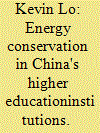

|
|
|
|
|
| Publication |
2013.
|
| Summary/Abstract |
This paper analyzes the energy conservation situation in China's higher education institutions (HEIs). A case study was conducted in Changchun, Jilin, where eight HEIs of various types were examined. An analysis of government policies was also performed. The findings indicate that the HEIs have implemented comprehensive non-technical initiatives to conserve electricity, including electricity restrictions and extensions of winter breaks, as well as certain technical initiatives. The HEIs are less enthusiastic in conserving thermal energy due to a lack of financial incentives and resources. Differences between the HEIs are also noted. This paper discusses the role of key players, including administrators, government agencies, networks, students and non-government organizations (NGOs). Challenges to energy conservation are also identified, such as the lack of investment by schools, lack of government funding, quality problems in energy conservation products, inadequate heat metering reform, underperformance of energy service companies (ESCOs), and conflicts between energy conservation and student welfare. Policy recommendations are offered based on the analysis results.
|
|
|
|
|
|
|
|
|
|
|
|
|
|
|
|
| 19 |
ID:
099313


|
|
|
|
|
| Publication |
2010.
|
| Summary/Abstract |
Since Taiwan lacks sufficient self-produced energy, increasing energy efficiency and energy savings are essential aspects of Taiwan's energy policy. This work summarizes the energy savings implemented by 303 firms in Taiwan's textile industry from the on-line Energy Declaration System in 2008. It was found that the total implemented energy savings amounted to 46,074 ton of oil equivalent (TOE). The energy saving was equivalent to 94,614 MWh of electricity, 23,686 kl of fuel oil and 4887 ton of fuel coal. It represented a potential reduction of 143,669 ton in carbon dioxide emissions, equivalent to the annual carbon dioxide absorption capacity of a 3848 ha plantation forest. This study summarizes energy-saving measures for energy users and identifies the areas for making energy saving to provide an energy efficiency baseline.
|
|
|
|
|
|
|
|
|
|
|
|
|
|
|
|
| 20 |
ID:
129919
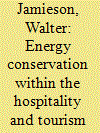

|
|
|
|
|
|
|
|